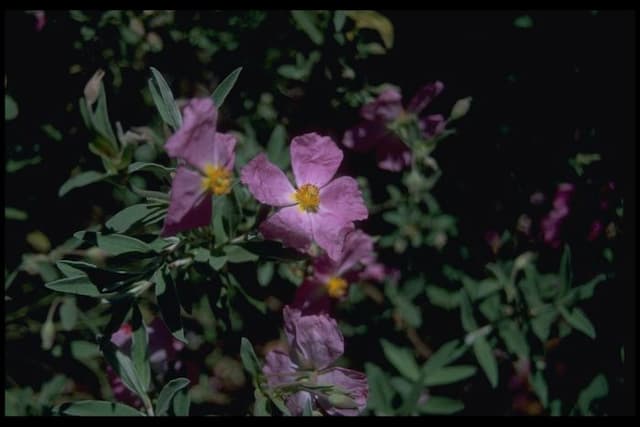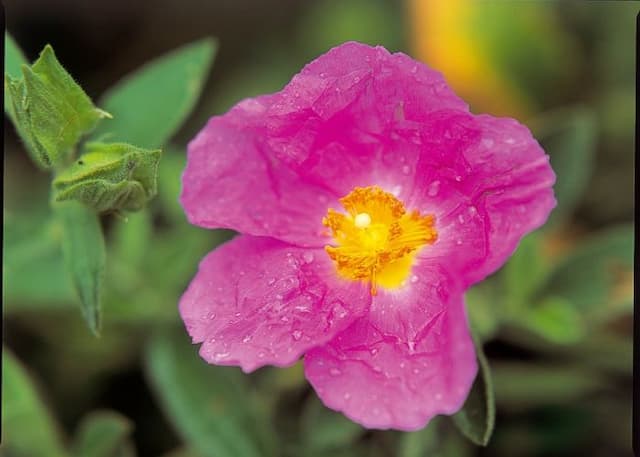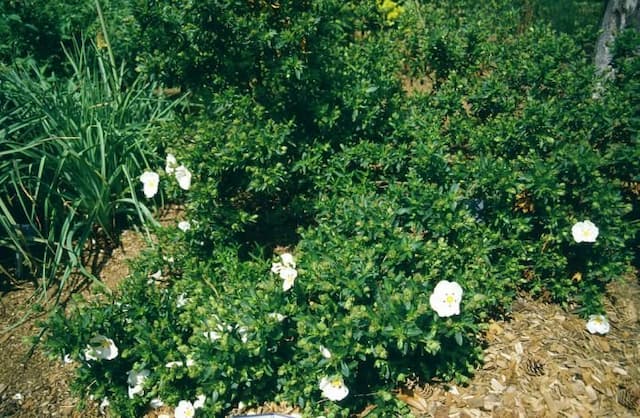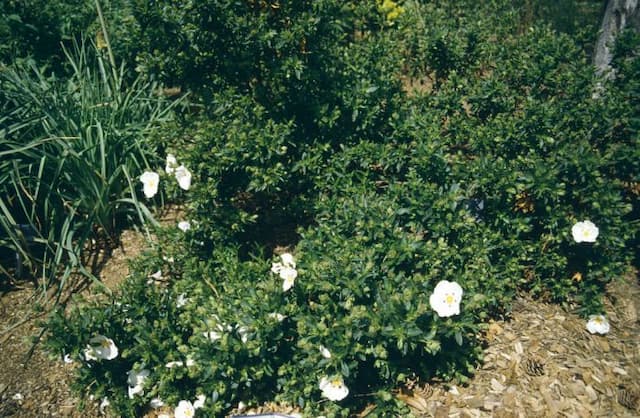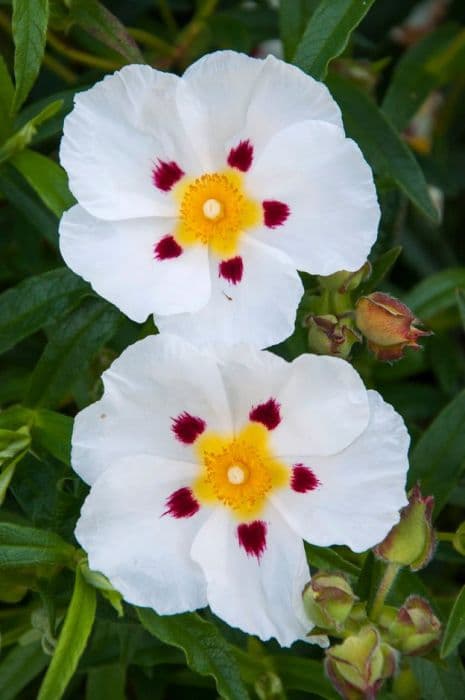Rock Rose Cistus × argenteus 'Peggy Sammons'

ABOUT
Cistus × argenteus 'Peggy Sammons', commonly known as rockrose 'Peggy Sammons', exhibits a striking appearance with a profusion of flowers and attractive foliage. It is a bushy evergreen that displays a dense, rounded form with a lush spread of slightly wavy, grey-green leaves. The leaves themselves are broad and have a soft, felt-like texture, contributing an overall silvery tone to the shrub. The most eye-catching feature of the rockrose 'Peggy Sammons' are its blossoms. During the flowering season, the plant is adorned with large, showy, rose-pink flowers. Each flower is comprised of five delicate petals that have a papery feel, and they often display a subtle sheen as if they have been dusted with a hint of silver. At the center of each bloom sits a prominent cluster of yellow stamens, providing a warm contrast to the cool hues of the petals. This burst of bloom grants the plant a spectacular display that is both vibrant and elegant. The rockrose 'Peggy Sammons' has an overall resilient and hardy demeanor. Its abundant blooming, coupled with the year-round ornamental leaves, makes it a favored choice for gardeners seeking to add a splash of color and texture to their landscapes without the need for intricate maintenance.
About this plant
 Names
NamesFamily
Cistaceae
Synonyms
Rock Rose, Sun Rose
Common names
Cistus × argenteus 'Peggy Sammons'.
 Toxicity
ToxicityTo humans
The Rockrose (Cistus × argenteus 'Peggy Sammons') is not known to be toxic to humans. In general, it does not contain any harmful compounds that would result in poisoning or adverse effects if parts of the plant are ingested by humans. Therefore, there are typically no symptoms of poisoning associated with this plant, and ingesting it should not lead to any serious consequences in terms of toxicity. However, it is always advisable to avoid eating plants that are not specifically intended for human consumption, as they could cause digestive upset or allergic reactions in some individuals.
To pets
The Rockrose (Cistus × argenteus 'Peggy Sammons') is generally not considered to be toxic to pets either. It does not typically contain substances that are harmful to dogs, cats, or other domestic animals if ingested. Consequently, there are no specific symptoms of poisoning expected if pets consume parts of this plant. While the Rockrose is not toxic, it is nonetheless prudent to prevent pets from ingesting plants, as they may cause gastrointestinal upset or other non-toxic related issues in some animals.
 Characteristics
CharacteristicsLife cycle
Perennials
Foliage type
Evergreen
Color of leaves
Green
Flower color
Pink
Height
3 feet (0.91 meters)
Spread
5 feet (1.52 meters)
Plant type
Shrub
Hardiness zones
8
Native area
Mediterranean
Benefits
 General Benefits
General Benefits- Low Maintenance: Cistus × argenteus 'Peggy Sammons', commonly known as Rock Rose, is a low maintenance plant that does not require frequent watering or complex care.
- Drought Tolerance: As a Mediterranean native, the Rock Rose is well adapted to dry conditions and can survive with minimal water once established.
- Attracts Pollinators: Its large, showy flowers attract bees, butterflies, and other beneficial pollinators to the garden.
- Decorative Use: With its attractive silvery foliage and pink flowers, the Rock Rose is widely used for ornamental purposes in gardens and landscapes.
- Erosion Control: The plant's root system can help prevent soil erosion, making it a good choice for slopes and banks.
- Deer Resistant: Rock Rose is known to be resistant to deer, which can be advantageous in areas where deer browsing is a problem for gardening.
- Fast Growth: It grows relatively quickly, providing coverage and visual interest in a short amount of time.
- Adaptability: Cistus × argenteus 'Peggy Sammons' adapts well to a variety of soil types, though it prefers well-drained soils.
 Medical Properties
Medical PropertiesThis plant is not used for medical purposes.
 Air-purifying Qualities
Air-purifying QualitiesThis plant is not specifically known for air purifying qualities.
 Other Uses
Other Uses- Cistus × argenteus 'Peggy Sammons', commonly known as Rockrose, can be used in the production of a sticky resin called labdanum. Labdanum is collected from the leaves and stems and is used in perfumery for its ambergris-like fragrance.
- Rockrose leaves have been historically used to treat leather. The tannins found in the leaves can be used in tanning processes to create more durable and resistant leather products.
- The dense, low-growing nature of Rockrose makes it an excellent plant for controlling soil erosion on slopes and banks, as its root system helps hold the soil in place.
- Rockrose can be incorporated into fire risk landscaping, particularly in fire-prone areas, as it is relatively fire-resistant after establishing itself.
- The fibrous stems of Rockrose have been used in traditional basket weaving, providing material for creating natural and rustic handcrafted items.
- Dried Rockrose plants can be utilized as a natural dye source, giving a range of colors from yellow to green, depending on the mordant used.
- Gardeners sometimes use Rockrose as a living mulch because its thick foliage helps suppress weeds and retain soil moisture.
- When pruned and maintained, Rockrose can be shaped into a low hedge or border, providing a structured aesthetic in garden landscapes.
- Rockrose petals are occasionally used in potpourri mixtures, contributing a subtle fragrance and decorative element.
- The flowering period of Rockrose attracts pollinators like bees and butterflies, thereby supporting local biodiversity and pollination in gardens.
Interesting Facts
 Feng Shui
Feng ShuiThe Rockrose is not used in Feng Shui practice.
 Zodiac Sign Compitability
Zodiac Sign CompitabilityThe Rockrose is not used in astrology practice.
 Plant Symbolism
Plant Symbolism- Beauty and Attraction: The 'Peggy Sammons' variety of Cistus, commonly known as Rockrose, showcases beautiful flowers that symbolize attraction and the greater beauty found in nature.
- Survival and Resilience: Rockrose plants are known for their ability to thrive in poor soils and resist drought, symbolizing one's ability to persist and adapt even in challenging conditions.
- Healing: The plant is associated with healing due to its historical use in folk medicine, suggesting spiritual or emotional recovery.
 Water
WaterRockrose 'Peggy Sammons' should be watered deeply but infrequently, allowing the soil to dry out between watering sessions. In general, watering once a week with approximately 1 to 1.5 gallons of water should be sufficient for established plants during active growth seasons, spring and summer. Water less during fall and cut back significantly during winter to once a month or less, depending on rainfall and soil drainage. It's crucial to avoid over-watering as this plant is drought-tolerant and prefers dry conditions once established.
 Light
LightRockrose 'Peggy Sammons' thrives in full sun and should be placed in a spot where it can receive at least six to eight hours of direct sunlight each day. An ideal location is a south-facing garden that ensures ample sunlight for strong growth and flowering. Avoiding deeply shaded areas is important, as too little light can hinder blooming and weaken the plant.
 Temperature
TemperatureRockrose 'Peggy Sammons' is tolerant of a wide range of temperatures but performs best in conditions that mimic its Mediterranean origin. It can withstand temperatures down to around 20 degrees Fahrenheit but might suffer damage in colder climates without protection. Ideal growing temperatures are between 60 and 75 degrees Fahrenheit during the growing season. It is a heat-loving plant that can handle high summer temperatures well into the 90s Fahrenheit.
 Pruning
PruningRockrose 'Peggy Sammons' should be pruned to maintain shape and encourage bushier growth. The best time to prune is right after the blooming period in late spring or early summer. Prune lightly, cutting back the plant by about one-third to remove spent flowers and to stimulate new growth. Annual pruning helps to rejuvenate the plant and keeps it looking tidy.
 Cleaning
CleaningAs needed
 Soil
SoilRockrose 'Peggy Sammons' thrives in well-drained soil with a soil pH range of 6.0 to 8.0. A mix of loam, sand, and peat moss is ideal, allowing good root aeration and preventing waterlogging. Regular garden soil can be amended with coarse sand and organic compost to improve drainage and fertility.
 Repotting
RepottingRockrose 'Peggy Sammons' should be repotted every 2 to 3 years or when it outgrows its pot. It's best to repot in spring before the onset of the growing season, minimizing stress and allowing the plant to establish in the new container.
 Humidity & Misting
Humidity & MistingRockrose 'Peggy Sammons' is adaptable to a range of humidity conditions but prefers moderate levels. It is not demanding regarding atmospheric humidity, making it suitable for most garden and open landscape situations.
 Suitable locations
Suitable locationsIndoor
Provide bright light and good airflow.
Outdoor
Plant in full sun, shelter from harsh winds.
Hardiness zone
8-11 USDA
 Life cycle
Life cycleCistus × argenteus 'Peggy Sammons', commonly known as Rockrose, starts its life as a seed, which requires well-drained soil and plenty of sunlight to germinate. Once sprouted, the seedling grows rapidly in favorable conditions, typically requiring a Mediterranean climate with dry summers and mild, wet winters. The plant enters a juvenile phase, where it establishes a strong root system and starts developing its characteristic silvery foliage. Upon reaching maturity, the Rockrose produces large, showy pink flowers in late spring to early summer, attracting pollinators to assist in reproduction. After pollination, it sets seed, which may be dispersed by wind or animals, allowing the cycle to begin anew. The Rockrose is a perennial shrub, so after the flowering season, it returns to a vegetative state and can live for several years, undergoing multiple flowering cycles.
 Propogation
PropogationPropogation time
Spring to Early Summer
Cistus × argenteus 'Peggy Sammons', commonly known as Rockrose, is best propagated through semi-hardwood cuttings. The ideal time to take these cuttings is in late summer to early autumn. To propagate using this method, a cutting of about 4 to 6 inches (10 to 15 centimeters) is taken from a healthy, non-flowering stem. The bottom leaves are removed, and the cut end is dipped in rooting hormone to encourage root growth. This treated cutting is then placed in a well-draining rooting medium and kept in a warm, humid environment until roots have developed, usually within a few weeks. After rooting, the new plant can be potted up and eventually planted out in the garden.

